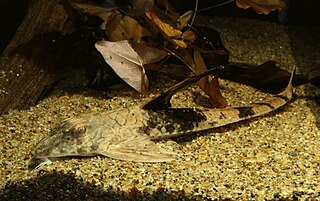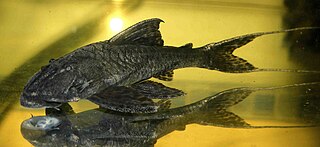
Ancistrus is a genus of nocturnal freshwater fish in the family Loricariidae of order Siluriformes, native to freshwater habitats in South America and Panama. Fish of this genus are common in the aquarium trade where they are known as bushynose or bristlenose catfish. In the aquarium hobby they are often referred to as bushynose or bristlenose plecos instead, but this may lead to confusion as "pleco" usually is used for Hypostomus plecostomus and its allies and is often used as a catchall term for any loricariids remotely resembling that species.

Loricariidae is the largest family of catfish, with 92 genera and just over 680 species. Loricariids originate from freshwater habitats of Costa Rica, Panama, and tropical and subtropical South America. These fish are noted for the bony plates covering their bodies and their suckermouths. Several genera are sold as "plecos", notably the suckermouth catfish, Hypostomus plecostomus, and are popular as aquarium fish.

Hypostomus is a genus of catfish in the family Loricariidae. They are native to tropical and subtropical South America. H. plecostomus is the popular freshwater aquarium fish formerly known as Plecostomus plecostomus. The taxonomic structure of the Loricariidae is still being expanded by scientists. Hypostomus is a highly species-rich and widely distributed catfish genus.

Baryancistrus is a genus of freshwater Loricariid catfish. They inhabit flowing sections of rivers, especially clearwater, in the basins of the Amazon and Orinoco in Brazil and Venezuela. The largest species reach up to 34 cm (13 in) in total length.

Rineloricaria is a genus of freshwater tropical catfish belonging to the family Loricariidae. They are commonly called whiptail catfish because of the long filament that grows out of the tip of the caudal fin that is characteristic of the genus. With the exception of R. altipinnis from Panama, they are native to the rivers of northern and central South America. Some species are regularly seen in the aquarium trade.

Peckoltia is a genus of small South American armored suckermouth catfishes. Many of these fish are popular aquarium fish.

Hemiancistrus is a genus of suckermouth armored catfishes. These species are native to South America. The taxonomy of this genus is complex and unclear, and major work has to be done. Many of these fish are popular aquarium fish.

Farlowella is a genus of fish in the family Loricariidae native to South America. This genus is broadly distributed in Amazon, Orinoco, Paraná and coastal rivers of the Guyana Shield. It is absent from the Pacific slope of the Andes and from the coastal rivers of the Brazilian Shield. Many of these species are kept in aquariums. This genus has a unique body shape that resembles a thin stick of wood. The body is slender and elongate, often with a pronounced rostrum and a brownish color with two lateral dark stripes beginning at the tip of the rostrum, passing over the eyes and ending at the tail, which are periodically interrupted on the caudal peduncle.
Ixinandria steinbachi is the only species in the genus Ixinandria of catfish of the family Loricariidae.

The Hypoptopomatinae are a subfamily of catfishes of the family Loricariidae, composed of 17 genera and approximately 80 species. This subfamily represents about one-tenth of all loricariid species.
Harttia is a genus of armored catfishes native to South America.

Loricaria is a genus of armored catfish native to South America.

The Hypostominae are a subfamily of catfishes of the family Loricariidae. Most members are restricted to tropical and subtropical South America, but there are also several species in southern Central America. Hypostomus plecostomus, which is popular in the aquarium trade, has been introduced to several regions far from its native range.

Ancistrini is a tribe of catfishes of the family Loricariidae. Most are restricted to tropical and subtropical South America, but there are also several genus in southern Central America.
Panaque bathyphilus is an Amazonian species of armoured catfish from the family Loricariidae. The holotype of the species was collected in the Solimões River, upstream of its confluence with the Purus River. This species has been known in the aquarium trade, at least since 1992, as papa panaque or under the L-number code L090. It reaches up to about 40 cm (16 in) in length.

Peckoltia pankimpuju is a species of armored catfish from the family Loricariidae, native to the Marañón River in the upper Amazon basin of Peru. It is commonly called the coal pleco, Peruvian lyre-tail, and L350 under the L-number code. It reaches up to about 40 cm (16 in) in length.
Scott Allen Schaefer is an American ichthyologist working at the American Museum of Natural History as the dean of science for collections, exhibitions, and the public understanding of science; he serves as the curator-in-charge, in the department of ichthyology, within the division of vertebrate zoology.
Panaqolus gnomus, sometimes known as the dwarf panaque, is a species of catfish in the family Loricariidae. It is a freshwater fish native to South America, where it occurs in the basins of the Pastaza River and the Marañón River. The species reaches 7.1 cm SL. It is the type species of the genus Panaqolus, which was historically considered to be a clade of small-sized species within the genus Panaque, hence the common name of this species.
Pseudoqolus koko is a species of catfish in the family Loricariidae and the only species in the genus Pseudoqolus. It is a freshwater fish native to South America, where it occurs in the Maroni basin. It is usually found on or near stony substrates in the main river channel at a depth of around 2 m. The species has been collected alongside multiple other loricariid species, including Hemiancistrus medians, Peckoltia otali, Pseudancistrus barbatus, Harttia guianensis, Loricaria cataphracta, and Rineloricaria stewarti. It is noted that the gut contents of one specimen of this species contained primarily spicules and sponge fragments, indicating that it may feed on freshwater sponges. The species reaches 9 cm SL.
Panaqolus purusiensis is a species of catfish in the family Loricariidae. It is native to South America, where it occurs in the Macauã River basin in the Purus River drainage in Brazil for which it is named, although it has also been recorded from the Curanja River, which is also part of the Purus drainage in Peru. The species reaches 13 cm SL. It was redescribed in 2014 by Christian A. Cramer due to a lack of information on the species from the original description, which was based on a single specimen.












